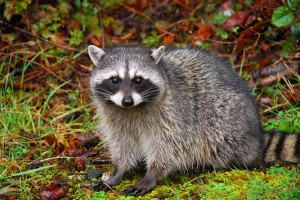Raccoons Description and Habitats
Raccoons range in size from 12 to 36 pounds having a body 26 to 38 inches long including a 10 inch tail. Their coat is long and thick, grizzled, grayish brown, black mask below white eyebrows. Legs are medium in length; paws are puffy and they have flexible toes used for climbing. They are primarily nocturnal but may be active during the day, especially in the spring and summer when the female is nursing her young and requires more food. They do not hibernate.
Raccoons are opportunists. They will eat anything ranging from fruits, berries, acorns, nuts to worms, fish, turtles, mice, crayfish, clams, snails to even eggs and young of birds and reptiles. And you guessed it, your garbage and pet foods would be a treat for them.
Raccoons prefer hardwood forests near streams, rivers, swamps or ponds. They are highly adaptable which is why they tend to be very successful surviving and thriving in your neighborhoods. They may find residence in your chimney, attics, crawl spaces, culverts, commercial buildings and abandoned autos—just a few places where we have performed our raccoon trapping and removal services.
Raccoons breed in late January to February. Gestation takes approximately 63 days. Typical birthing periods are from March through May. However, late breeding females may give birth as late as August. Raccoons are polygamous, females raise the young alone. In fact, the males will potentially kill the kits if they find them. Typical litter is 3 to 5 kits.
Raccoons Damage and the Health Hazards
At Wildlife Busters we enjoy the raccoon and its distinctive features, so much so that we have incorporated it into our logo. But its not just its distinctive physical characteristics that we admire, its their uncanny ability to invade secured attic vents, travel up and down open chimneys, and the creativity of which they use to survive in our ever expanding communities. Raccoons often den in the spring in preparation of their young and they normally do so in attics and chimneys. Chimneys are a safe haven because most predators of the juvenile raccoons cannot access the den allowing the raccoons to grow to a point of self survival. On a daily basis in the spring we provide raccoon removal services to remove these raccoons from their den because of the hazards they can bring to property owners. Raccoons can carry diseases such as rabies and distemper and often defecate in sections of their den which can contain a parasite called raccoon round worm. In addition to the diseases, raccoons will destroy attic insulation which they utilize for nesting material. Unfortunately, raccoons don’t understand the soaring costs of energy nor the expense of an attic restoration service.
Raccoon Removal Services
At Wildlife Busters we believe that prevention is always the best policy when it come to dealing with nuisance wildlife. Proper repairs to a commercial or residential building, maintenance plans and inspectional services are just a part of what might help you avoid having to deal with a wildlife removal issue. Some helpful tips include:
- Make sure vents are sealed properly
- Install a chimney cap
- Secure trash in trash cans
- Seal all openings in and around your home (ie soffits, siding etc.)
Wondering how to get rid of raccoons? There is no magic spray or device that you can use to make them go away. Some people try to sell predator urine, such as coyote or fox urine to get rid of raccoons, but that doesn’t work. They also try to sell ultrasonic sound emitters. These devices are worthless at eliminating raccoons. Some old wive’s tales recommend the use of mothballs or ammonia-soaked rags to make them leave, but I’ve been to countless homes where these techniques failed – biologists know that these attempts won’t work. The ONE AND ONLY WAY to take care of your problem is with animal trapping and removal services.
Picture by Matt D

 Receive FREE wildlife Tips!
Receive FREE wildlife Tips!

